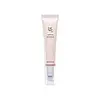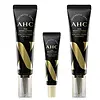What's inside
What's inside
 Key Ingredients
Key Ingredients

 Benefits
Benefits

 Concerns
Concerns

 Ingredients Side-by-side
Ingredients Side-by-side

Water
Skin ConditioningPanax Ginseng Root Extract
EmollientGlycerin
HumectantDipropylene Glycol
HumectantCaprylic/Capric Triglyceride
Masking1,2-Hexanediol
Skin ConditioningPentaerythrityl Tetraethylhexanoate
EmollientNiacinamide
SmoothingButylene Glycol Dicaprylate/Dicaprate
EmollientCetearyl Alcohol
EmollientSorbitan Olivate
EmulsifyingCetearyl Olivate
Butylene Glycol
HumectantHydrogenated Lecithin
EmulsifyingTromethamine
BufferingCarbomer
Emulsion StabilisingGlyceryl Stearate
EmollientMacadamia Ternifolia Seed Oil
EmollientAdenosine
Skin ConditioningTheobroma Cacao Extract
Skin ConditioningDextrin
AbsorbentCholesterol
EmollientPolyglyceryl-10 Oleate
Skin ConditioningRetinal
Skin ConditioningBrassica Campestris Sterols
EmollientPhytosteryl/Behenyl/Octyldodecyl Lauroyl Glutamate
Skin ConditioningSilica
AbrasiveSodium Hyaluronate
HumectantTocopherol
AntioxidantAluminum/Magnesium Hydroxide Stearate
Emulsion StabilisingPotassium Cetyl Phosphate
EmulsifyingPentaerythrityl Tetra-Di-T-Butyl Hydroxyhydrocinnamate
AntioxidantCeramide NP
Skin ConditioningPalmitoyl Tripeptide-5
Skin ConditioningDisodium EDTA
Ethylhexylglycerin
Skin ConditioningWater, Panax Ginseng Root Extract, Glycerin, Dipropylene Glycol, Caprylic/Capric Triglyceride, 1,2-Hexanediol, Pentaerythrityl Tetraethylhexanoate, Niacinamide, Butylene Glycol Dicaprylate/Dicaprate, Cetearyl Alcohol, Sorbitan Olivate, Cetearyl Olivate, Butylene Glycol, Hydrogenated Lecithin, Tromethamine, Carbomer, Glyceryl Stearate, Macadamia Ternifolia Seed Oil, Adenosine, Theobroma Cacao Extract, Dextrin, Cholesterol, Polyglyceryl-10 Oleate, Retinal, Brassica Campestris Sterols, Phytosteryl/Behenyl/Octyldodecyl Lauroyl Glutamate, Silica, Sodium Hyaluronate, Tocopherol, Aluminum/Magnesium Hydroxide Stearate, Potassium Cetyl Phosphate, Pentaerythrityl Tetra-Di-T-Butyl Hydroxyhydrocinnamate, Ceramide NP, Palmitoyl Tripeptide-5, Disodium EDTA, Ethylhexylglycerin
Hydrolyzed Collagen Extract
Skin ProtectingGlycerin
HumectantDipropylene Glycol
HumectantBifida Ferment Lysate
Skin ConditioningHydrogenated Polydecene
EmollientCyclohexasiloxane
EmollientCaprylic/Capric Triglyceride
MaskingDicaprylyl Carbonate
EmollientWater
Skin ConditioningNiacinamide
SmoothingCaprylic/Capric/Succinic Triglyceride
EmollientCetearyl Alcohol
EmollientGlyceryl Stearate Se
EmulsifyingPentaerythrityl Stearate/Caprate/Caprylate/Adipate
EmollientCetyl Alcohol
EmollientButyrospermum Parkii Butter
Skin ConditioningBetaine
HumectantPhellodendron Amurense Bark Extract
Skin ConditioningCamellia Sinensis Leaf Extract
AntimicrobialLycium Chinense Leaf Extract
Skin ConditioningCentella Asiatica Extract
CleansingFicus Carica Fruit Extract
HumectantDioscorea Japonica Root Extract
Skin ConditioningOryza Sativa Extract
AbsorbentAloe Barbadensis Leaf Extract
EmollientCollagen Extract
Skin ConditioningPseudoalteromonas Ferment Extract
HumectantAcmella Oleracea Extract
Skin ProtectingGossypium Herbaceum Seed Extract
Skin ConditioningSolanum Lycopersicum Fruit Extract
AntioxidantPersea Gratissima Fruit Extract
EmollientLepidium Meyenii Root Extract
Skin ConditioningSalicornia Herbacea Extract
Skin ConditioningCinnamomum Zeylanicum Bark Extract
AntimicrobialBacillus/Folic Acid Ferment Filtrate Extract
AntioxidantPancratium Maritimum Extract
BleachingNymphaea Alba Flower Extract
Skin ConditioningTriticum Aestivum Peptide
Skin ConditioningPhaseolus Lunatus Seed Extract
EmollientHydrogenated Lecithin
EmulsifyingCocos Nucifera Oil
MaskingMacadamia Integrifolia Seed Oil
Skin ConditioningSodium Hyaluronate
HumectantSoluble Collagen
HumectantCamellia Sinensis Leaf Water
MaskingOryza Sativa Germ Oil
EmollientSimmondsia Chinensis Seed Oil
EmollientPolyglyceryl-10 Myristate
Skin ConditioningCetearyl Olivate
Sorbitan Olivate
EmulsifyingMethylpropanediol
SolventPolyglyceryl-10 Laurate
Skin ConditioningDimethicone/Vinyl Dimethicone Crosspolymer
Skin ConditioningPolyacrylate-13
Hydrolyzed Collagen Extract, Glycerin, Dipropylene Glycol, Bifida Ferment Lysate, Hydrogenated Polydecene, Cyclohexasiloxane, Caprylic/Capric Triglyceride, Dicaprylyl Carbonate, Water, Niacinamide, Caprylic/Capric/Succinic Triglyceride, Cetearyl Alcohol, Glyceryl Stearate Se, Pentaerythrityl Stearate/Caprate/Caprylate/Adipate, Cetyl Alcohol, Butyrospermum Parkii Butter, Betaine, Phellodendron Amurense Bark Extract, Camellia Sinensis Leaf Extract, Lycium Chinense Leaf Extract, Centella Asiatica Extract, Ficus Carica Fruit Extract, Dioscorea Japonica Root Extract, Oryza Sativa Extract, Aloe Barbadensis Leaf Extract, Collagen Extract, Pseudoalteromonas Ferment Extract, Acmella Oleracea Extract, Gossypium Herbaceum Seed Extract, Solanum Lycopersicum Fruit Extract, Persea Gratissima Fruit Extract, Lepidium Meyenii Root Extract, Salicornia Herbacea Extract, Cinnamomum Zeylanicum Bark Extract, Bacillus/Folic Acid Ferment Filtrate Extract, Pancratium Maritimum Extract, Nymphaea Alba Flower Extract, Triticum Aestivum Peptide, Phaseolus Lunatus Seed Extract, Hydrogenated Lecithin, Cocos Nucifera Oil, Macadamia Integrifolia Seed Oil, Sodium Hyaluronate, Soluble Collagen, Camellia Sinensis Leaf Water, Oryza Sativa Germ Oil, Simmondsia Chinensis Seed Oil, Polyglyceryl-10 Myristate, Cetearyl Olivate, Sorbitan Olivate, Methylpropanediol, Polyglyceryl-10 Laurate, Dimethicone/Vinyl Dimethicone Crosspolymer, Polyacrylate-13
 Reviews
Reviews

Ingredients Explained
These ingredients are found in both products.
Ingredients higher up in an ingredient list are typically present in a larger amount.
This ingredient is an emollient, solvent, and texture enhancer. It is considered a skin-softener by helping the skin prevent moisture loss.
It helps thicken a product's formula and makes it easier to spread by dissolving clumping compounds.
Caprylic Triglyceride is made by combining glycerin with coconut oil, forming a clear liquid.
While there is an assumption Caprylic Triglyceride can clog pores due to it being derived from coconut oil, there is no research supporting this.
Learn more about Caprylic/Capric TriglycerideCetearyl alcohol is a mixture of two fatty alcohols: cetyl alcohol and stearyl alcohol. It is mainly used as an emulsifier. Emulsifiers help prevent the separation of oils and products. Due to its composition, it can also be used to thicken a product or help create foam.
Cetearyl alcohol is an emollient. Emollients help soothe and hydrate the skin by trapping moisture.
Studies show Cetearyl alcohol is non-toxic and non-irritating. The FDA allows products labeled "alcohol-free" to have fatty alcohols.
This ingredient is usually derived from plant oils such as palm, vegetable, or coconut oils. There is debate on whether this ingredient will cause acne.
Due to the fatty acid base, this ingredient may not be Malassezia folliculitis safe.
Learn more about Cetearyl AlcoholCetearyl Olivate is an emulsifier and texture enhancer. It is derived from the fatty acids of olive oil and Cetearyl alcohol, and is biodegradable.
As an emulsifier, it is used to prevent oils and waters from separating. It can also
Manufacturers use the name Olivem 1000. This ingredient has been found to preserve the natural microbiome of skin. Having a healthy microbiome helps keep our skin healthy and protects against harmful bacteria. This ingredient is grouped with Sorbitan Olivate under the name Olivem 1000.
Learn more about Cetearyl OlivateDipropylene Glycol is a synthetically created humectant, stabilizer, and solvent.
This ingredient helps:
Dipropylene glycol is technically an alcohol, but it belongs to the glycol family (often considered part of the ‘good’ alcohols). This means it is hydrating and gentle on skin unlike drying solvent alcohols like denatured alcohol.
As a masking agent, Dipropylene Glycol can be used to cover the smell of other ingredients. However, it does not have a scent.
Studies show Dipropylene Glycol is considered safe to use in skincare.
Learn more about Dipropylene GlycolGlycerin is already naturally found in your skin. It helps moisturize and protect your skin.
A study from 2016 found glycerin to be more effective as a humectant than AHAs and hyaluronic acid.
As a humectant, it helps the skin stay hydrated by pulling moisture to your skin. The low molecular weight of glycerin allows it to pull moisture into the deeper layers of your skin.
Hydrated skin improves your skin barrier; Your skin barrier helps protect against irritants and bacteria.
Glycerin has also been found to have antimicrobial and antiviral properties. Due to these properties, glycerin is often used in wound and burn treatments.
In cosmetics, glycerin is usually derived from plants such as soybean or palm. However, it can also be sourced from animals, such as tallow or animal fat.
This ingredient is organic, colorless, odorless, and non-toxic.
Glycerin is the name for this ingredient in American English. British English uses Glycerol/Glycerine.
Learn more about GlycerinHydrogenated Lecithin is created from the hydrogenation of lecithin (a group of phospholipids). Hydrogenation is a chemical reaction between hydrogen and another element.
This ingredient is an emollient and emulsifier. As an emollient, it helps soften skin by trapping moisture within. As an emulsifier, it prevents oil and water ingredients from separating.
Niacinamide is a multitasking form of vitamin B3 that strengthens the skin barrier, reduces pores and dark spots, regulates oil, and improves signs of aging.
And the best part? It's gentle and well-tolerated by most skin types, including sensitive and reactive skin.
You might have heard of "niacin flush", or the reddening of skin that causes itchiness. Niacinamide has not been found to cause this.
In very rare cases, some individuals may not be able to tolerate niacinamide at all or experience an allergic reaction to it.
If you are experiencing flaking, irritation, and dryness with this ingredient, be sure to double check all your products as this ingredient can be found in all categories of skincare.
When incorporating niacinamide into your routine, look out for concentration amounts. Typically, 5% niacinamide provides benefits such as fading dark spots. However, if you have sensitive skin, it is better to begin with a smaller concentration.
When you apply niacinamide to your skin, your body converts it into nicotinamide adenine dinucleotide (NAD). NAD is an essential coenzyme that is already found in your cells as "fuel" and powers countless biological processes.
In your skin, NAD helps repair cell damage, produce new healthy cells, support collagen production, strengthen the skin barrier, and fight environmental stressors (like UV and pollution).
Our natural NAD levels start to decline with age, leading to slower skin repair, visible aging, and a weaker skin barrier. By providing your skin niacinamide, you're recharging your skin's NAD levels. This leads to stronger, healthier, and younger looking skin.
Another name for vitamin B3 is nicotinamide. This vitamin is water-soluble and our bodies don't store it. We obtain Vitamin B3 from either food or skincare. Meat, fish, wheat, yeast, and leafy greens contain vitamin B3.
The type of niacinamide used in skincare is synthetically created.
Learn more about NiacinamideSodium Hyaluronate is hyaluronic acid's salt form. It is commonly derived from the sodium salt of hyaluronic acid.
Like hyaluronic acid, it is great at holding water and acts as a humectant. This makes it a great skin hydrating ingredient.
Sodium Hyaluronate is naturally occurring in our bodies and is mostly found in eye fluid and joints.
These are some other common types of Hyaluronic Acid:
Learn more about Sodium HyaluronateSorbitan Olivate is created from the fatty acids in olive oil and sorbitol.
This ingredient is an oil in water emulsifier. It helps stabilize a product by preventing oils and waters from separating. Sorbitan Olivate also helps hydrate the skin.
Manufacturers sell sorbitan olivate under the name OliveM 1000. OliveM 1000 a multifunctional ingredient. It is self-emulsifying. According to a manufacturer, OliveM 1000 does not disrupt natural skin biome.
Due to its olive oil base, this ingredient may not be fungal-acne safe.
Learn more about Sorbitan OlivateWater. It's the most common cosmetic ingredient of all. You'll usually see it at the top of ingredient lists, meaning that it makes up the largest part of the product.
So why is it so popular? Water most often acts as a solvent - this means that it helps dissolve other ingredients into the formulation.
You'll also recognize water as that liquid we all need to stay alive. If you see this, drink a glass of water. Stay hydrated!
Learn more about Water